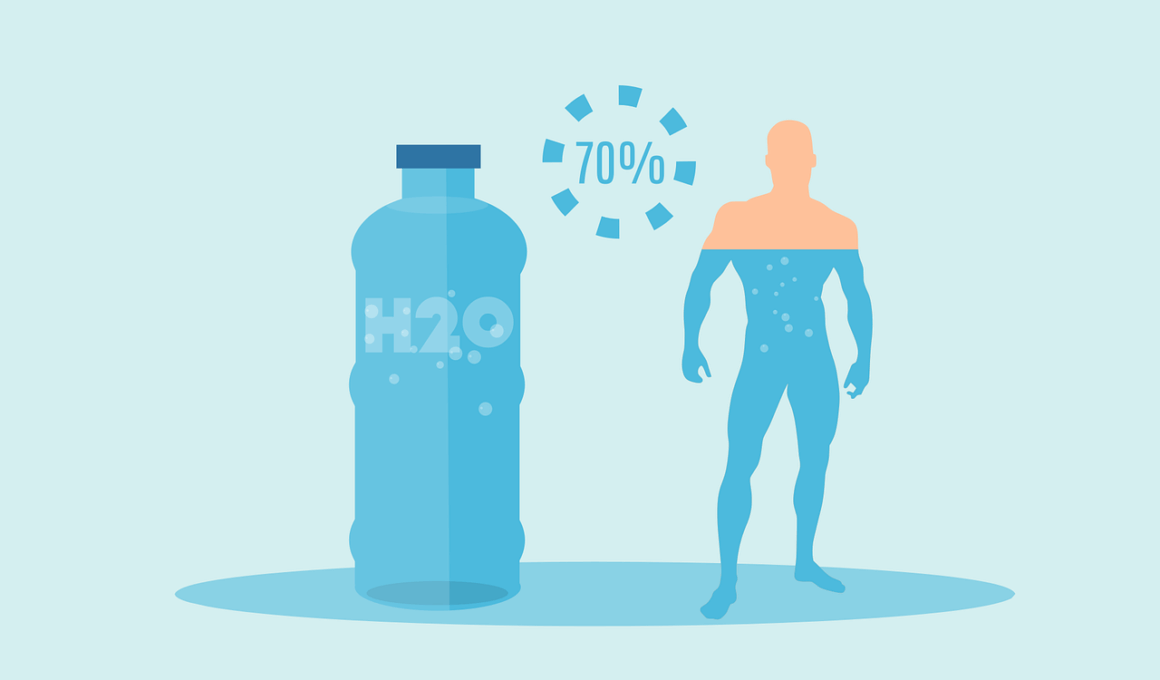CrossFit Injury Prevention: Hydration for Joint and Muscle Health
Hydration is fundamental in optimizing performance during CrossFit sessions and preventing injuries. Joint and muscle health directly correlate with hydration levels in the body. When you are well-hydrated, your joints lubricate more efficiently. This lubrication lowers the risk of friction-related injuries that can occur during high-intensity workouts. Your body also utilizes water for muscle contractions. Dehydrated muscles may not function effectively and can lead to cramps or strains. It is vital to integrate proper hydration strategies into your workout routine, such as drinking sufficient fluids before, during, and after exercises. Aim to consume water consistently throughout the day, not just during workouts. Testing for your hydration level can include checking the color of your urine; pale yellow indicates adequate hydration. Remember that you might need more fluids in hot weather or during tough sessions. Additionally, incorporating fruits and vegetables with high water content can bolster your hydration efforts. Stay ahead of hydration for safe, effective training and better performance. Actively consider these insights for a healthier CrossFit experience.
Hydration needs vary for everyone, influenced by factors such as individual metabolism, exercise intensity, and environmental conditions. Listening to your body is essential; thirsty feelings signify that your fluid intake may be insufficient. A proactive approach to hydration involves establishing a routine that includes drinking water regularly, even when you are not thirsty. Water is the most straightforward, best choice, but you can also integrate sports drinks for replenishing electrolytes, especially post-workout. During intense sessions, electrolyte-rich fluids can replace vital minerals lost through sweat. Create a tailored hydration plan based on your specific needs by considering workout length and intensity. Keeping a water bottle nearby during workouts serves as a visual reminder to hydrate consistently. Moreover, pre-hydration, about 2-3 hours before workouts, ensures optimal hydration levels. Experiment with different hydration strategies to find what suits you best; everyone’s body reacts differently. Overall, hydration is integral to enhancing your performance and decreasing the risk of injury while participating in CrossFit. Prioritize fluid intake, and embrace a healthier fitness lifestyle.
The Role of Nutrition in Hydration
Understanding the connection between nutrition and hydration is crucial for CrossFit athletes. Foods high in water content can complement fluid intake and help maintain hydration levels. For instance, fruits like watermelon, oranges, and strawberries consist of around 90% water, which contributes significantly to your daily hydration. Consuming vegetables like cucumbers, celery, and lettuce can also enhance water consumption. Including these nutrient-dense foods in your diet supports overall hydration while providing essential vitamins and minerals for joint and muscle health. Moreover, balancing electrolytes is vital, particularly sodium, potassium, and magnesium, which can be lost through sweat during workouts. Incorporating sports drinks post-workout can help replenish these electrolytes. Conversely, avoid excessive intake of caffeinated and alcoholic beverages, as they may contribute to dehydration. Plan your meals around your workout schedule for ideal hydration benefits; consuming hydrating meals before and after sessions can maximize performance and recovery. Prioritize whole foods rich in water while working towards a balanced diet to enhance hydration and overall health.
Furthermore, consider the timing of your hydration. Pre-exercise hydration is essential for fueling your body and preparing it for physical activity. Aim for about 500 mL of water 2-3 hours before starting your workout. Reassess your hydration habits during your CrossFit routine to pinpoint areas for improvement. During workouts lasting longer than one hour, it is beneficial to take small sips of water or an electrolyte drink every 15-20 minutes. This consistent intake helps maintain hydration levels and combats fatigue. Post-workout hydration recovery also plays a vital role in overall health. Consuming water or electrolyte-rich beverages will aid in reducing muscle soreness and support joint health. Remember that hydration is not just about plain water; choose options that suit your taste preferences and make it enjoyable. Address any feelings of fatigue or dizziness promptly, as they could indicate dehydration. Learn to read your body’s signals and tailor your hydration strategy accordingly. Taking charge of your hydration empowers you to prevent injuries and improve your performance during CrossFit.
Signs of Dehydration
Being aware of dehydration signs can tremendously influence your performance and overall health in CrossFit. Common symptoms include thirst, dry mouth, fatigue, dizziness, and decreased urine output, indicating that your body lacks adequate fluids. Muscle cramps can also signal that your hydration levels are low. Moreover, cognitive functions such as focus and alertness may decline when dehydrated, leading to slower reaction times, potentially increasing the risk of injuries. To prevent dehydration, monitor your water intake and adjust it based on environmental conditions and exercise duration. During intense workouts, replenish fluids promptly, paying attention to how you feel. It’s also vital to check urine color; a light yellow signifies good hydration, while dark urine suggests a need for water. Don’t overlook the importance of staying hydrated even during rest days; your body continuously loses fluids. Educate yourself on effective hydration practices and adjust your habits accordingly. Prioritizing hydration is a small yet powerful change that can enhance your training experience and contribute to injury prevention during CrossFit.
Additionally, creating a hydration log can be beneficial for tracking your fluid intake throughout the day and optimizing your hydration strategies. This log will help you stay accountable and allow you to identify patterns that may need adjustment. Document your workouts and daily activities to assess how hydration affects your performance, energy levels, and recovery. The goal is to develop consistent hydration habits that become second nature. Utilize reminders on your phone or hydration apps to facilitate regular water consumption. Incorporate water-rich snacks such as smoothies or coconut water for variety. Sports drinks containing electrolytes can also offer a welcome change, particularly after intense workouts. Not only does tracking hydration encourage awareness, but it also engages you actively in your health journey. Emphasizing hydration during CrossFit can lead to continually improved performance, reduced soreness, and enhanced muscle health. Create a personalized hydration plan that best fits your lifestyle and workout schedule for optimal results. Hydration is key to achieving your athletic potential.
Conclusion: Empowering Hydration Strategies
In conclusion, prioritizing hydration in your CrossFit journey is paramount for joint and muscle health while preventing injuries. Understanding your body’s hydration needs and educating yourself on effective strategies can significantly enhance your performance. Develop a hydration routine that aligns with your workouts, incorporating various fluid and food sources that facilitate adequate hydration. Stay mindful of hydration, acknowledging signs of dehydration, and adjust your water intake accordingly. Engage in self-monitoring through hydration logs or using apps to stay accountable and maximize your hydration strategies. Evaluate your individual needs based on environmental conditions, activity levels, and personal preferences. Adequate hydration ultimately leads to better performance and reduced injury risks while allowing you to enjoy CrossFit. By integrating hydration habits into your routine and recognizing their importance, you set yourself up for long-term health and success in fitness. Make hydration a priority, ensuring that it becomes an effortless part of your CrossFit lifestyle. Together, we create a healthier, stronger, and more resilient CrossFit community focused on injury prevention.
Furthermore, continuing to educate yourself on hydration and its impacts can also empower you as an athlete. Making informed decisions about fluid intake and nutrition fosters improved health outcomes and ensures a greater recovery and performance. Explore various hydration techniques and experiment with different methods to discover what works best for you. Staying adaptable and seeking guidance from professionals, like nutritionists or trainers, can provide personalized insights for optimum hydration. Consider the hydration culture around you; promote awareness among members of your CrossFit community about its significance. Attend workshops, seminars, and engage in discussions about effective hydration strategies to encourage learning and growth. By sharing your experiences and tips, you contribute to creating a supportive environment where everyone prioritizes well-being. Hydration should not be an afterthought but rather an essential part of your fitness routine. Stay connected with fellow CrossFit enthusiasts and exchange ideas on ways to stay hydrated effectively while performing at your best. Ultimately, a well-informed approach leads to a healthier and more successful CrossFit experience for all.


